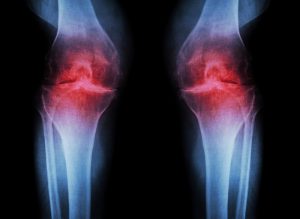What is osteoarthritis?
 Osteoarthritis is also known as osteoarthrosis, degenerative arthritis, senile arthritis, commonly known as “bone hyperplasia” or “spurs”.
Osteoarthritis is also known as osteoarthrosis, degenerative arthritis, senile arthritis, commonly known as “bone hyperplasia” or “spurs”.
It is mainly due to age, obesity, strain, trauma and other factors caused by degeneration of articular cartilage, joint edge and subchondral bone hyperplasia, clinical manifestations of slow development of joint pain, tenderness and stiffness, joint effusion, joints Swelling, limited joint activity, and joint deformities.
The most influential to the human body is the involvement of the knee joint, which makes it difficult to go up and down the stairs, and the difficulty of squatting. The development will also affect the walking on the ground. It is one of the diseases with the highest disability rate in middle-aged and old people.
Some patients have a frictional or “squeaky” sound when they are active. In severe cases, they may have muscle atrophy and joint deformity. It has caused great inconvenience to the lives of middle-aged and elderly people, and travel has become a luxury. If you use X-rays for the elderly, you will find that the prevalence of osteoarthritis in people over 50 is about 50%, that is, about half of the elderly have osteoarthritis, but it is actually obvious. The symptoms that cause difficulty walking are not that much. The main treatment for this disease is to reduce the weight of the joints and excessive large-scale activities to delay the progression of the disease. Obese patients should lose weight and reduce joint load. When the knee is severe, a crutches or canes can be used to reduce the burden on the joints. There is currently no good medical treatment. Chondroprotective agents such as glucosamine sulfate and diacerein can be tried to control inflammation, but the effect is uncertain. In advanced cases, people with joint deformities and joint dysfunction need surgery. In general, there is currently no good conservative treatment for osteoarthritis.
Stages of osteoarthritis
Osteoarthritis (OA) is divided into five stages. Stage 0 is assigned to a normal, healthy knee. The highest stage, 4, is assigned to severe OA. OA that has become this advanced is likely to cause significant pain and disrupt joint movement.
Stage 0
Stage 0 OA is classified as “normal” knee health. The knee joint shows no signs of OA and the joint functions without any impairment or pain.
Stage 1
A person with stage 1 OA is showing very minor bone spur growth. Bone spurs are boney growths that often develop where bones meet each other in the joint.
Someone with stage 1 OA will usually not experience any pain or discomfort as a result of the very minor wear on the components of the joint.
Stage 2
Stage 2 OA of the knee is considered a “mild” stage of the condition. X-rays of knee joints in this stage will reveal greater bone spur growth, but the cartilage is usually still at a healthy size, i.e. the space between the bones is normal, and the bones are not rubbing or scraping one another.
At this stage, synovial fluid is also typically still present at sufficient levels for normal joint motion.
However, this is the stage where people may first begin experiencing symptoms—pain after a long day of walking or running, greater stiffness in the joint when it’s not used for several hours, or tenderness when kneeling or bending.
Stage 3
Stage 3 OA is classified as “moderate” OA. In this stage, the cartilage between bones shows obvious damage, and the space between the bones begins to narrow. People with stage 3 OA of the knee are likely to experience frequent pain when walking, running, bending, or kneeling.
They also may experience joint stiffness after sitting for long periods of time or when waking up in the morning. Joint swelling may be present after extended periods of motion, as well.
Stage 4
Stage 4 OA is considered “severe.” People in stage 4 OA of the knee experience great pain and discomfort when they walk or move the joint.
That’s because the joint space between bones is dramatically reduced—the cartilage is almost completely gone, leaving the joint stiff and possibly immobile. The synovial fluid is decreased dramatically, and it no longer helps reduce the friction among the moving parts of a joint.
Our Cryo Stem Cell Clinic has orthopedic specialist who has been focused on knee and joint problems by treating with Mesenchymal Stem Cell (MSC).
There are 2 options for the treatment of knee and joint problems with Mesenchymal Stem Cells;
• For Osteoarthritis stage 1, 2 and 3
In these stages, we called mild and moderate stages of OA, we treat the problems by injecting Mesenchymal Stem Cell directly into the affected joints to promote the cartilage regrowth and to reduce the inflammation of the joints.
• For Osteoarthritis stage 4
This is the most severe stage of OA. In this stage, a small part of the bone from the body is taken out and perform the bone to grow cartilage by culturing the bone with stem cells in the laboratory. After the cartilage has grown, the bone is transplanted back to the patient’s knees or joints. This whole procedure is performed by orthopedic specialist and the result is better and faster.
Mesenchymal stem cells (MSCs) can differentiate themselves into bones, tendons and muscles. From this special feature, MSC can be used for knee and joint treatment. By injecting the MSC into the affected area, infection and inflammation in the affected area can be reduced, and bones, tendons and muscles can be reconstructed.
Please click here for more information.




